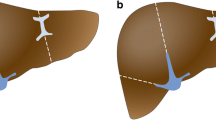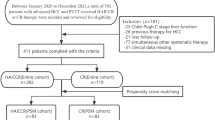Abstract
Sarcomatoid hepatocellular carcinoma (sHCC) is a rare phenotype of HCC with extremely poor prognosis and no established pharmacological treatment. Interventional therapies such as radiofrequency ablation (RFA) or transcatheter arterial embolization (TAE) have been shown to limit the development of sHCC through mechanisms involving hypoxia-induced epithelial–mesenchymal transition. This report describes an 83-year-old man who developed sHCC 2 years after RFA treatment for HCC and experienced sHCC rupture. Following TAE-induced hematostasis, he was administered lenvatinib for tumor control. Although his physical status had improved, due to loss of fever and attenuation of arterial enhancement in the tumor, for 1 month after lenvatinib administration, tumor re-growth was observed 2 months after lenvatinib treatment. His general condition was preserved, and he was treated with 10 courses of atezolizumab plus bevacizumab (Atez+Bev), resulting in tumor shrinkage that was maintained for 3–8 months after Atez+Bev. Findings in this patient showed that combined immunotherapy was effective for sHCC. Further investigation in additional patients is required to maximize prognosis in patients with sHCC.




Similar content being viewed by others
References
Enjoji M. Liver: undifferentiated carcinoma. Atlas Genet Cytogenet Oncol Hematol. 2011;15:542–3.
Yokogawa N, Yanagawa H, Kitade H, Yuri T, Kwon AH. A case of hepatocellular carcinoma with sarcomatous change without anticancer therapies showing rapid reccurence after hepatectomy. Kanzo. 2014;55:206–13.
Theise ND, Curado MP, Franceschi S, et al. Hepatocellular carcinoma. In: Bosman FT, Carneiro F, Hruban RH, et al., editors. WHO classification of tumors of the digestive system. 4th ed. Lyon, France: IARC Press; 2010. p. 205–16.
Kakizoe S, Kojiro M, Nakashima T. Hepatocellular carcinoma with sarcomatous change. clinicopathologic and immunohistochemical studies of 14 autopsy cases. Cancer. 1987;59:310–6.
Kojiro M, Sugihara S, Kakizoe S, Nakashima O, Kiyomatsu K. Hepatocellular carcinoma with sarcomatous change. A special reference to the relationship with anticancer therapy. Cancer Chemother Pharmacol. 1989;23:4–8.
Koda M, Maeda Y, Matsunaga Y, et al. Hepatocellular carcinoma with sarcomatous change arising after radiofrequency ablation for well-differentiated hepatocellular carcinoma. Hepatol Res. 2003;27:163–7.
Maeda T, Kayashima H, Imai D, et al. Undifferentiated carcinoma of liver: a case report with immunohistochemical analysis. Surg Case Rep. 2017;3:12.
Kawamura Y, Kobayashi M, Shindoh J, et al. Pretreatment heterogeneous enhancement pattern of hepatocellular carcinoma may be a useful new predictor of early response to lenvatinib and overall prognosis. Liver Cancer. 2020;9:275–92.
Kawamura Y, Ikeda K, Hirakawa M, et al. New classification of dynamic computed tomography images predictive of malignant characteristics of hepatocellular carcinoma. Hepatol Res. 2010;40:1006–14.
Kasagi Y, Yoshizumi T, Nakashima T, et al. A Case of undifferentiated hepatocellular carcinoma presenting with fever. J Jpn Surg Assoc. 2010;71:2411–6.
Komatsubara T, Fujimoto K, Asari K, et al. A granulocyte-colony stimulating factor producing undifferentiated hepatocellular carcinoma. Jpn J Gastroenterol Surg. 2015;48:582–9.
Nakadai E, Takeuchi D, Noro M, et al. Granulocyte colony-stimulating factor producing undifferentiated liver carcinoma: a case report. Kanzo. 2019;60:147–55.
Yamada S, Utsunomiya T, Morine Y, et al. Expressions of HIF-1 and EpCAM are linked with aggressive local recurrence of hepatocellular carcinoma after radiofrequency ablation therapy. Ann Surg Oncol. 2014;21:S436–42.
Zhang X, Wang X, Jia L, et al. CtBP1 mediates hypoxia-induced sarcomatoid transformation in hepatocellular carcinoma. J Hepatocell Carcinoma. 2022;9:57–67.
Yoshida S, Kornek M, Ikenaga N, et al. Sublethal heat treatment promote epithelial-mesenchymal transition and malignant potential of hepatocellular carcinoma. Hepatology. 2013;58:1667–80.
Zhu SG, Li HB, Yuan ZN, et al. Achievement of complete response to nivolumab in a patient with advanced sarcomatoid hepatocellular carcinoma. World J Gastrointest Oncol. 2020;12:1209–15.
Morisue R, Kojima M, Suzuki T, et al. Sarcomatoid hepatocellular carcinoma distinct from ordinary hepatocellular carcinoma: clinicopathologic, transcriptomic and immunologic analyses. Int J Cancer. 2021;149:546–60.
Lou Y, Diao L, Cuetanos ER, et al. Epithelial-mesenchymal transition is associated with a distinct tumor microenvironment including elevation of inflammatory signals and multiple immune checkpoints in lung adenocarcinoma. Clin Cancer Res. 2016;22:3630–42.
Tsutumi S, Saeki H, Nakashima Y, et al. Programmed death-ligand 1 expression at tumor invasive front is associated with epithelial-mesenchymal transition and poor prognosis in esophageal squamous cell carcinoma. Cancer Sci. 2017;108:1119–27.
Kimura T, Kato Y, Ozawa Y, et al. Immunomodulatory activity of lenvatinib contributes to antitumor activity in the Hepa1-6 hepatocellular carcinoma model. Cancer Sci. 2018;109:3993–4002.
Wu YL, Fulgenzi CAM, D’Allesio A, et al. Neutrophil-to-lymphocyte and platelet-to-lymphocyte ratios as prognostic biomarkers in unresectable hepatocellular carcinoma treated with atezolizumab plus bevacizumab. Cancers (Basel). 2022;14:5834.
Scheiner B, Pomej K, Kirstein MM, et al. Prognosis of patients with hepatocellular carcinoma treated with immunotherapy – development and validation of the CRFATY score. J Hepatol. 2022;76:353–63.
Kumar AR, Devan AR, Nair B, et al. Anti-VEGF mediated immunomodulatory role of phytochemicals: Scientific exposition for plausible HCC treatment. Curr Drug Targets. 2021;22:1288–316.
Acknowledgements
We thank English Service for Scientists for English language editing.
Author information
Authors and Affiliations
Corresponding author
Ethics declarations
Conflict of interest
All authors declare that they have no conflict of interest.
Human rights
All methods were performed in accordance with the relevant guidelines and regulations including the Declaration of Helsinki.
Informed consent
Informed consent was obtained from the patient to be included in the study.
Additional information
Publisher's Note
Springer Nature remains neutral with regard to jurisdictional claims in published maps and institutional affiliations.
Supplementary Information
Below is the link to the electronic supplementary material.
Rights and permissions
Springer Nature or its licensor (e.g. a society or other partner) holds exclusive rights to this article under a publishing agreement with the author(s) or other rightsholder(s); author self-archiving of the accepted manuscript version of this article is solely governed by the terms of such publishing agreement and applicable law.
About this article
Cite this article
Goto, Y., Tajiri, K., Tanaka, S. et al. A ruptured sarcomatoid hepatocellular carcinoma treated with combined immunotherapy. Clin J Gastroenterol 16, 244–249 (2023). https://doi.org/10.1007/s12328-023-01758-1
Received:
Accepted:
Published:
Issue Date:
DOI: https://doi.org/10.1007/s12328-023-01758-1




